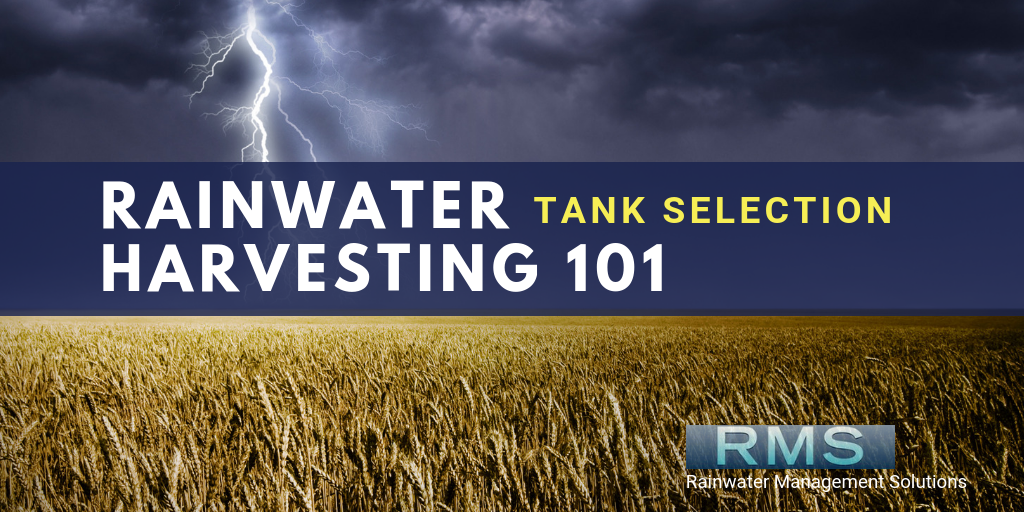
Continuing on our Rainwater Harvesting 101 Post series, we will look at storage tank selection.
One of the first factors to consider when designing a rainwater harvesting system is your expected usage compared to expected rainwater collection. Tank size is a very important factor for the overall rainwater harvesting system (which we will get into later in the post) and also becomes a big factor in the price of a system. Factors that frequently come into play with selecting a tank are:
- Storage Capacity: will this tank allow me to collect enough water to achieve the sustainability goal I have set?
- Location: above or below ground?
- Materials of construction: plastic? metal? fiberglass? concrete?
- Space restrictions: Am I limited by height or footprint?
- Cost: does the tank fit my budget?
It is key when selecting a tank to make sure that you take into account all of the factors above.
Storage Capacity
This is an important aspect of a rainwater harvesting system because you want to size the tank appropriately to a.) allow overflow and b.) not overflow all the time, while also allowing the tank to serve your needs for your project. Allowing the tank to overflow helps to remove floating particulate from the tank as well as create movement of water and provide excess incoming water a place to go in the event that the tank is full.
We implement tank sizing software to help determine the proper tank size for your project based on historical rainfall data, expected water usage, and several other factors. If you need assistance sizing your tank, fill out the tank sizing form and one of our team members will contact you!
Location
Rainwater tank location plays a big factor in tank selection as water must be conveyed by gravity to the pre-tank filter and eventually the storage tank. This means that sometimes there simply is not enough elevation for above-ground tanks to work and below-ground tanks must be considered. Other times the elements must be considered and whereas an above-ground tank may be well suited for a warm climate like Florida, it is likely to be subject to freezing in a cold climate like Minnesota. Other physical factors can come into play as well where digging in rocky terrain or a high water table may make below-ground tanks more difficult/impossible to use.
At times...
...visibility may come into factor as well. I have worked on several projects where Homeowners Associations prohibit visible water tanks, but do not have issues with below-ground tanks. While above ground tanks tend to be less expensive than below ground tank options, below ground tanks can offer hiding conveyance piping and may make elevations much easier to accommodate.
On the contrary...
some projects are wanting to tout or "show off" the rainwater system and implement large above-ground storage tanks in their design.
While above ground tanks tend to be less expensive than below-ground tank options, below-ground tanks can offer hiding conveyance piping and may make elevations much easier to accommodate. Installation location has several factors, so consider all of them before coming to a decision.
Materials of Construction
This attribute comes into play primarily in terms of price, aesthetics, and potable vs. non-potable installation. As shown above, there are several types of rainwater harvesting cisterns. Examples are:
- Polyethylene (above or below ground, several different types available)
- Metal: corrugated or smooth; stainless steel, galvanized,
- Fiberglass (above or below ground)
- Concrete
- HDPE pipe
The end use should also be considered as not all rainwater tanks are suited for potable water storage by default and may require a specialty liner or finish (NSF 61 is typical).

All materials of construction offer their own advantages and disadvantages, so finding a happy medium is essential. For example, Polyethylene tends to be the most cost-effective option, but doesn't necessarily carry some of the aesthetic values that a metal tank does.
Space Restrictions
Here's an example of this factor: 50,000 gallons of storage is not a small volume to accommodate. So, while your project may be optimized to offset 97% of water demands at 50,000 gallons of storage, you may only have the physical space to accommodate 10,000 gallons of storage. Determining what you can accommodate will
Cost
Financial fit is also important as tanks can account for a sizable portion of a project's budget. Different tanks may also have different cost-associated factors such as shipping, specialty installation, expensive material of construction, and more. However, rainwater cisterns can also come into play and allow quicker returns on investment by allowing you to store and use more water if applicable to your project.
If you have any questions on tanks or how to properly size and select one, please contact us by phone, email or fill out the tank sizing form here!

